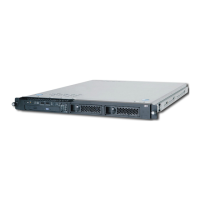5. Enter any requested passwords.
After any requested passwords have been entered, the system attempts to boot from
the first device of each type found on the list. If no bootable image is found on the first
device of each type on the list, the system does not search through the other devices of
that type for a bootable image; instead, it polls the first device of the next type.
If all types of devices in the boot list have been polled without finding a bootable image,
the system restarts, this gives the user the opportunity to start the System Management
Services ( by pressing the number 1 key on a directly attached keyboard or the number
1 on an ASCII terminal) before the system attempts to boot again.
Default Boot List and Service Mode Bootlist
The default boot list is as follows:
1. Diskette
2. CD-ROM
3. Tape
4. Hard file
5. Network
v Token-Ring
v Ethernet
Pressing the number 5 key on a directly attached keyboard (or the number 5 key on an
ASCII terminal) causes the system to load Standalone Diagnostics given that a
diagnostic CD is present in the CD-ROM drive.
Pressing the number 6 key on a directly attached keyboard (or number 6 key on an
ASCII terminal) loads Online Diagnostics from the service mode boot list. No
diagnostic CD should be in the CD-ROM drive because Online Diagnostics is typically
run from a hard disk, which is in the boot list defined using the system diagnostics
“Display or Change Bootlist” service aid. Like the default boot list, the service mode
boot list can contain five entries. The number 6 key works like the number 5 key, with
the following exceptions:
v The system searches for a boot record according to the service mode boot list.
v If the service mode boot list is discovered by a cyclical redundancy check to be
corrupted, the system rebuilds the service mode boot list according to the default
boot list. (The default boot list contains five entries, and for each matching device
type found in the system unit, the system makes an entry in the custom boot list.)
v If no service mode boot list is present, the system uses the default boot list.
446 Service Guide
